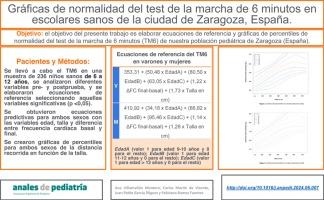Gráficas de normalidad del test de la marcha de seis minutos en escolares sanos de la ciudad de Zaragoza, España
IF 1.5
4区 医学
Q2 PEDIATRICS
引用次数: 0
Abstract
Introduction
The six-minute walk test is a stress test that provides information about exercise tolerance in chronic diseases. The aim of the study was to develop reference equations with normal values for the test in healthy children aged 6 to 12 years in our paediatric reference population.
Patients and methods
The six-minute walk test was carried out in a sample of 236 healthy children, analyzing pre- and post-test variables, and we developed reference equations selecting variables that turned out to be significant (P < .05).
Results
The pre- and post-test values, respectively, were 97.82% (SD, 0.64) vs 97.82% (SD, 0.59) for oxygen saturation; 96.59 bpm (SD, 16.11) vs 131.89 bmp (SD, 22.64) for the heart rate; 0.52 (SD, 0.83) vs 3.01 (SD, 2.42) for the degree of dyspnea (Borg scale) and 0.68 (SD, 0.98) vs 2.95 (SD, 2.26) for the degree of lower extremities fatigue (Borg scale). The average distance walked was 668.03 meters (SD, 87.36) (671.42 m in boys [SD, 92.2] vs 664.22 m in girls [SD, 81.81]). We fitted predictive equations that included the variables age, height and difference between baseline and final heart rate. We also generated percentile charts of the distance walked for height.
Conclusions
Age, height, regular physical activity and obesity had an impact on test results. Obtaining reference values for the 6-minute walk test in healthy children is necessary for its application in clinical practice.

西班牙萨拉戈萨市健康学童六分钟步行测试的正态曲线。
导言六分钟步行测试是一种压力测试,可提供慢性疾病患者的运动耐量信息。这项研究的目的是在我们的儿科参考人群中,为 6 至 12 岁的健康儿童制定具有正常值的六分钟步行测试参考方程。患者和方法我们对 236 名健康儿童进行了六分钟步行测试,分析了测试前和测试后的变量,并选择具有显著性(P < .05)。结果测试前后的血氧饱和度值分别为 97.82%(SD,0.64)vs 97.82%(SD,0.59);心率分别为 96.59 bpm(SD,16.11)vs 131.89 bmp(SD,22.心率为 96.59 bpm(SD,16.11) vs 131.89 bmp(SD,22.64);呼吸困难程度(博格量表)为 0.52(SD,0.83) vs 3.01(SD,2.42);下肢疲劳程度(博格量表)为 0.68(SD,0.98) vs 2.95(SD,2.26)。平均步行距离为 668.03 米(标度为 87.36)(男生为 671.42 米[标度为 92.2],女生为 664.22 米[标度为 81.81])。我们拟合了预测方程,其中包括年龄、身高和基线心率与最终心率之间的差异等变量。结论年龄、身高、经常运动和肥胖对测试结果有影响。要将 6 分钟步行测试应用于临床实践,就必须获得健康儿童 6 分钟步行测试的参考值。
本文章由计算机程序翻译,如有差异,请以英文原文为准。
求助全文
约1分钟内获得全文
求助全文
来源期刊

Anales de pediatria
医学-小儿科
CiteScore
2.10
自引率
4.80%
发文量
155
审稿时长
44 days
期刊介绍:
La Asociación Española de Pediatría tiene como uno de sus objetivos principales la difusión de información científica rigurosa y actualizada sobre las distintas áreas de la pediatría. Anales de Pediatría es el Órgano de Expresión Científica de la Asociación y constituye el vehículo a través del cual se comunican los asociados. Publica trabajos originales sobre investigación clínica en pediatría procedentes de España y países latinoamericanos, así como artículos de revisión elaborados por los mejores profesionales de cada especialidad, las comunicaciones del congreso anual y los libros de actas de la Asociación, y guías de actuación elaboradas por las diferentes Sociedades/Secciones Especializadas integradas en la Asociación Española de Pediatría.
 求助内容:
求助内容: 应助结果提醒方式:
应助结果提醒方式:


